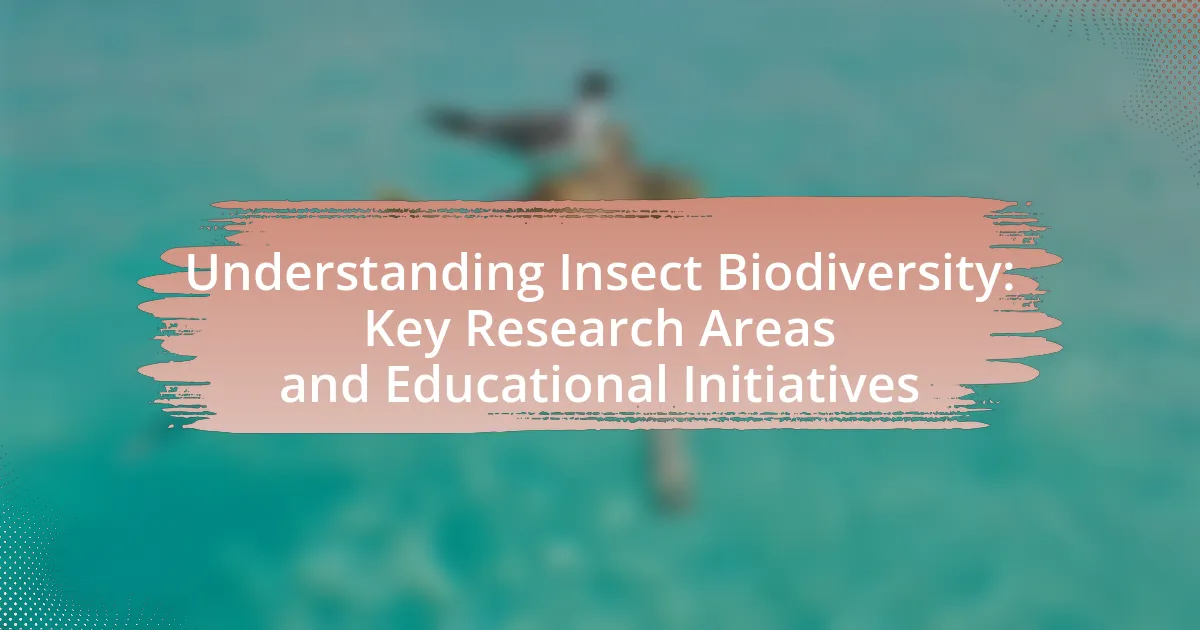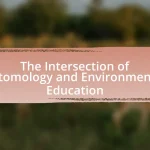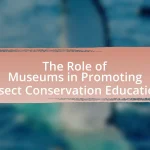Insect biodiversity encompasses the vast variety of insect species within ecosystems, with estimates suggesting around 10 million species globally. This article explores the significance of insect biodiversity for ecosystem resilience, productivity, and stability, highlighting their roles in pollination, decomposition, and nutrient cycling. It examines key research areas such as taxonomy, ecology, and the impacts of climate change on insect populations, while also discussing educational initiatives that promote understanding and conservation of insect diversity. The article emphasizes the importance of community engagement and citizen science in enhancing public awareness and participation in insect conservation efforts.
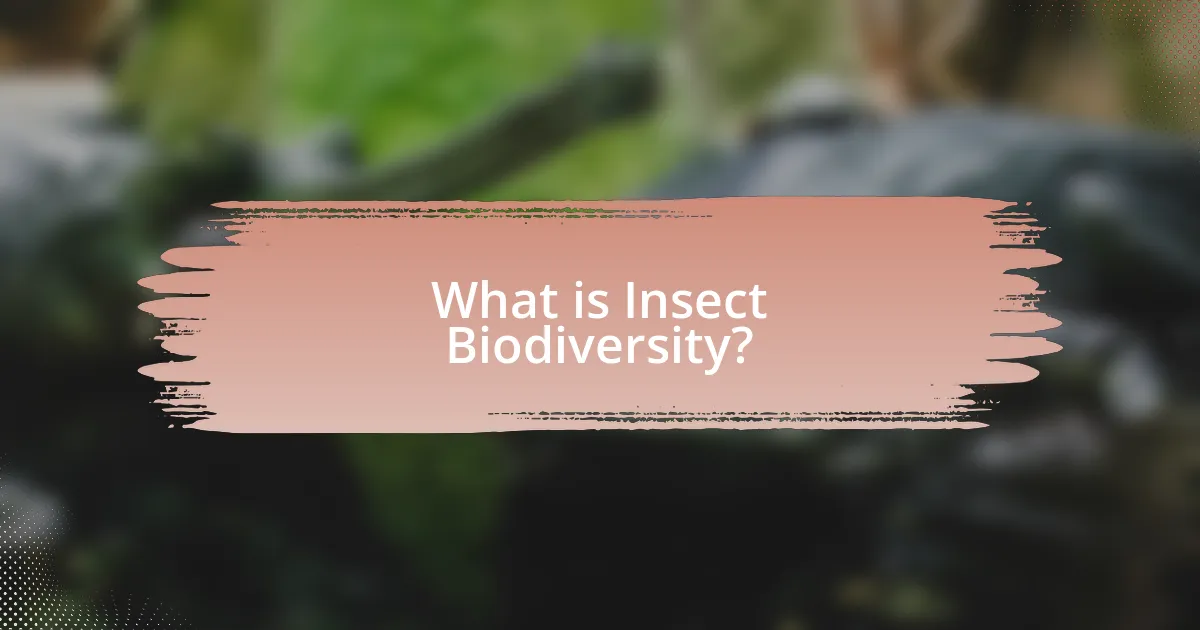
What is Insect Biodiversity?
Insect biodiversity refers to the variety and variability of insect species within a given ecosystem or on Earth as a whole. This diversity encompasses millions of species, with estimates suggesting that there are approximately 10 million insect species, of which about 1 million have been formally described. Insects play crucial roles in ecosystems, including pollination, decomposition, and serving as food for other organisms, which underscores their importance in maintaining ecological balance.
Why is Insect Biodiversity important for ecosystems?
Insect biodiversity is crucial for ecosystems because it enhances ecosystem resilience, productivity, and stability. Diverse insect populations contribute to essential ecological functions such as pollination, decomposition, and nutrient cycling. For instance, studies show that ecosystems with a higher diversity of pollinators can increase crop yields by up to 50%, demonstrating the direct impact of insect biodiversity on food production. Additionally, insects play a vital role in breaking down organic matter, which supports soil health and fertility, further underscoring their importance in maintaining balanced ecosystems.
How do insects contribute to pollination and plant reproduction?
Insects contribute to pollination and plant reproduction by transferring pollen from the male parts of flowers to the female parts, facilitating fertilization. This process is essential for the production of seeds and fruits in many flowering plants. For example, bees, butterflies, and beetles are key pollinators that enhance the reproductive success of approximately 75% of the world’s flowering plants, according to the Food and Agriculture Organization. This interaction not only supports biodiversity but also plays a critical role in agricultural productivity, as many crops depend on insect pollination for yield.
What role do insects play in nutrient cycling and decomposition?
Insects play a crucial role in nutrient cycling and decomposition by breaking down organic matter, which facilitates the recycling of nutrients back into the ecosystem. Decomposers such as beetles, ants, and termites consume dead plant and animal material, accelerating the decomposition process. This activity not only enriches the soil with essential nutrients but also enhances soil structure and fertility. Research indicates that insects contribute significantly to the decomposition of leaf litter, with studies showing that insect-mediated decomposition can increase nutrient availability by up to 50% in certain ecosystems.
What are the main components of Insect Biodiversity?
The main components of insect biodiversity include species richness, genetic diversity, and ecosystem diversity. Species richness refers to the number of different species present in a given area, which is crucial for maintaining ecological balance. Genetic diversity encompasses the variation in genes within a species, allowing for adaptability and resilience to environmental changes. Ecosystem diversity involves the variety of habitats and ecological processes that support different insect communities. These components are essential for understanding the overall health and functionality of ecosystems, as insects play vital roles in pollination, decomposition, and food webs.
How many species of insects exist globally?
Approximately 10 million species of insects exist globally. This estimate is supported by research indicating that insects represent the most diverse group of organisms on Earth, with around 1 million species formally described and many more yet to be identified. The high biodiversity of insects is crucial for ecosystems, contributing to pollination, decomposition, and food webs.
What are the different orders of insects and their characteristics?
Insects are classified into several orders, each with distinct characteristics. The major orders include Coleoptera (beetles), which are characterized by their hardened forewings and diverse feeding habits; Lepidoptera (butterflies and moths), known for their scaled wings and metamorphosis; Diptera (flies), which possess a single pair of wings and are often characterized by their rapid flight; Hymenoptera (ants, bees, and wasps), recognized for their social structures and complex behaviors; Hemiptera (true bugs), which have specialized mouthparts for piercing and sucking; and Orthoptera (grasshoppers and crickets), known for their jumping abilities and sound production. Each order plays a crucial role in ecosystems, contributing to pollination, decomposition, and food webs.
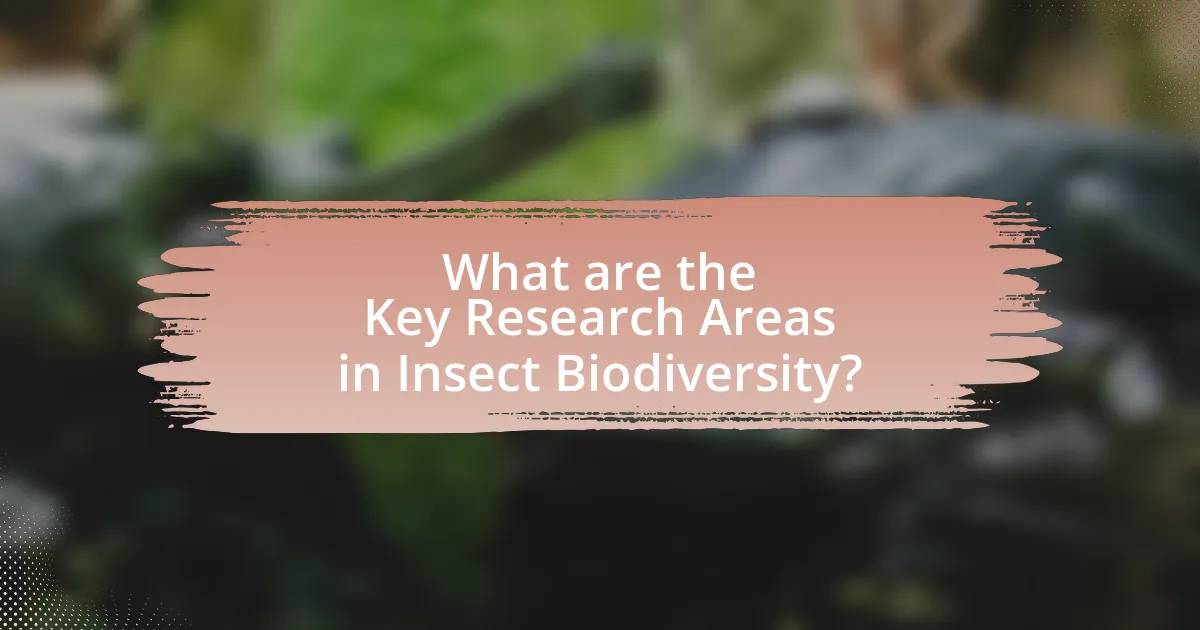
What are the Key Research Areas in Insect Biodiversity?
Key research areas in insect biodiversity include taxonomy, ecology, conservation biology, and the impacts of climate change. Taxonomy focuses on the classification and identification of insect species, which is essential for understanding biodiversity. Ecology examines the interactions between insects and their environments, providing insights into ecosystem functions. Conservation biology addresses the threats to insect populations and habitats, emphasizing the need for protective measures. Research on climate change investigates how shifting environmental conditions affect insect distribution, behavior, and survival. These areas are critical for developing strategies to preserve insect diversity and the ecosystems they support.
How does climate change affect insect populations?
Climate change significantly affects insect populations by altering their habitats, life cycles, and interactions with other species. Rising temperatures can lead to shifts in distribution, with many insects moving towards cooler areas, often resulting in decreased biodiversity in their original habitats. For instance, studies have shown that warmer temperatures can accelerate the development of insects, leading to earlier emergence and potentially mismatched timing with food sources, such as plants. Additionally, increased frequency of extreme weather events can disrupt breeding and survival rates. Research published in the journal “Nature Climate Change” highlights that approximately 40% of insect species are at risk of extinction due to climate-related factors, underscoring the critical impact of climate change on insect biodiversity.
What evidence exists linking climate change to insect decline?
Evidence linking climate change to insect decline includes shifts in insect populations and distributions due to rising temperatures and altered precipitation patterns. Research indicates that many insect species are experiencing range contractions, with studies showing that warmer climates lead to habitat loss and reduced food availability. For instance, a study published in the journal “Science” by Hallmann et al. (2017) reported a dramatic decline of 76% in flying insect biomass over 27 years in protected areas of Germany, correlating this decline with climate change impacts. Additionally, the Intergovernmental Panel on Climate Change (IPCC) reports that climate change is expected to exacerbate existing threats to insects, including habitat destruction and increased frequency of extreme weather events, further supporting the link between climate change and insect decline.
How can we mitigate the impacts of climate change on insects?
To mitigate the impacts of climate change on insects, we can implement habitat restoration and conservation strategies. These strategies involve preserving and restoring natural habitats, which provide essential resources for insects, such as food and shelter. Research indicates that maintaining biodiversity within ecosystems enhances resilience to climate change, as diverse insect populations can better adapt to environmental changes. For instance, a study published in the journal “Nature” highlights that ecosystems with higher insect diversity are more stable and can recover more quickly from climate-related disturbances. Additionally, reducing pesticide use and promoting organic farming practices can create healthier environments for insects, further supporting their populations in the face of climate change.
What are the methods used to study Insect Biodiversity?
The methods used to study insect biodiversity include field surveys, molecular techniques, and ecological modeling. Field surveys involve direct observation and collection of insects in various habitats, allowing researchers to document species richness and distribution. Molecular techniques, such as DNA barcoding, enable the identification of species based on genetic material, providing precise taxonomic information. Ecological modeling uses statistical and computational methods to predict species distributions and assess the impacts of environmental changes on insect populations. These methods collectively enhance our understanding of insect biodiversity and its ecological significance.
What technologies are employed in insect monitoring and identification?
Technologies employed in insect monitoring and identification include remote sensing, DNA barcoding, and acoustic monitoring. Remote sensing utilizes satellite imagery and drones to assess insect populations and habitats over large areas, providing valuable data for ecological studies. DNA barcoding allows for precise species identification through genetic analysis, enabling researchers to catalog biodiversity accurately. Acoustic monitoring captures insect sounds, facilitating the identification of species based on their unique calls. These technologies enhance the efficiency and accuracy of insect monitoring, contributing to a better understanding of biodiversity and ecosystem health.
How do researchers collect and analyze insect data?
Researchers collect and analyze insect data through various methods, including field surveys, trapping, and molecular techniques. Field surveys involve systematically observing and recording insect species in their natural habitats, often using standardized protocols to ensure consistency. Trapping methods, such as pitfall traps, light traps, and sweep nets, are employed to capture insects for identification and population studies. Molecular techniques, including DNA barcoding, allow researchers to analyze genetic material for species identification and phylogenetic studies. These methods are supported by extensive literature, such as the study by Hebert et al. (2003) in “Molecular Ecology Notes,” which demonstrates the effectiveness of DNA barcoding in identifying insect species.
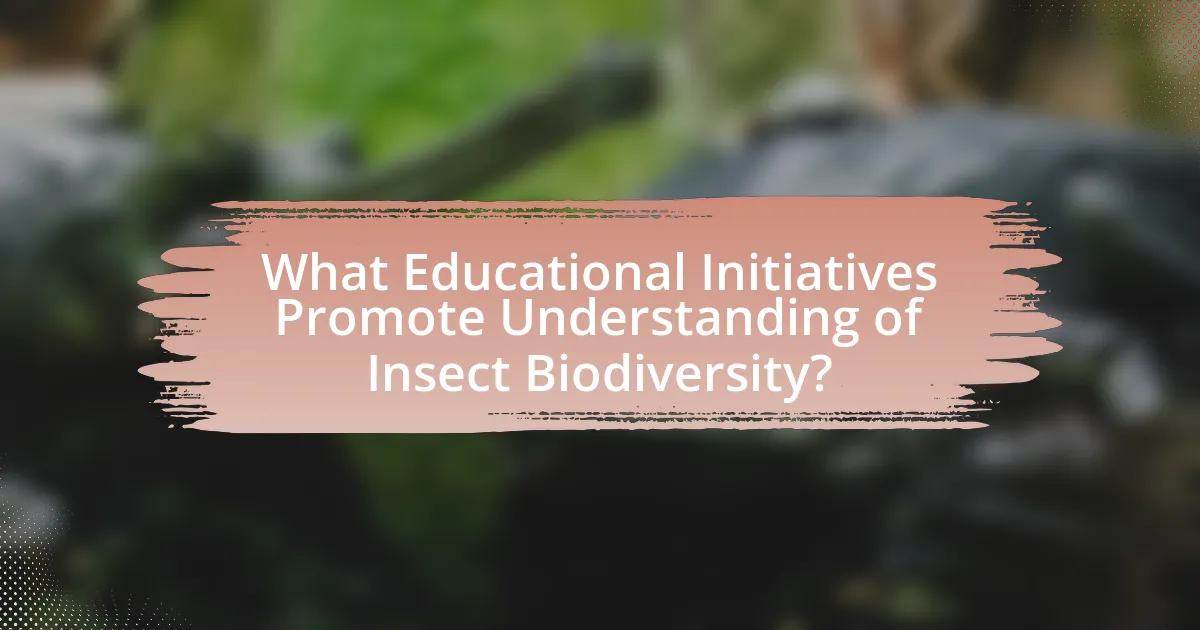
What Educational Initiatives Promote Understanding of Insect Biodiversity?
Educational initiatives that promote understanding of insect biodiversity include citizen science programs, school curricula focused on entomology, and public outreach campaigns. Citizen science programs, such as the iNaturalist platform, engage individuals in observing and documenting insect species, thereby enhancing public knowledge and data collection on biodiversity. School curricula that incorporate hands-on activities related to insects, such as the “Insect Discovery” program, provide students with direct experiences that foster appreciation and understanding of insect roles in ecosystems. Public outreach campaigns, like National Pollinator Week, raise awareness about the importance of insects, particularly pollinators, in maintaining ecological balance and food production. These initiatives collectively contribute to a broader understanding of insect biodiversity and its significance.
How can schools incorporate insect biodiversity into their curriculum?
Schools can incorporate insect biodiversity into their curriculum by integrating hands-on activities, such as insect collection and observation, into science lessons. This approach allows students to engage directly with local ecosystems, fostering a deeper understanding of species diversity and ecological roles. Research indicates that experiential learning enhances student retention of scientific concepts; for example, a study published in the Journal of Biological Education found that students who participated in field studies demonstrated a 30% increase in knowledge retention compared to traditional classroom instruction. Additionally, schools can utilize resources like citizen science projects, where students contribute to real-world data collection on insect populations, further enriching their learning experience and promoting environmental stewardship.
What hands-on activities can enhance student engagement with insects?
Hands-on activities that can enhance student engagement with insects include insect collection and identification, habitat creation, and interactive insect observation. Insect collection allows students to gather specimens from various environments, fostering curiosity and direct interaction with biodiversity. Habitat creation, such as building butterfly gardens or insect hotels, encourages students to understand ecological relationships and the needs of different species. Interactive observation, through activities like using magnifying glasses or microscopes, enables students to explore insect anatomy and behavior closely. These activities have been shown to increase interest and knowledge in entomology, as evidenced by studies indicating that experiential learning significantly boosts student engagement and retention of information in science education.
How can teachers use local ecosystems to teach about insects?
Teachers can use local ecosystems to teach about insects by conducting field studies that allow students to observe and interact with various insect species in their natural habitats. This hands-on approach enhances understanding of insect biodiversity, life cycles, and ecological roles. For instance, by exploring a local park or garden, students can identify different insects, collect data on their behaviors, and analyze their interactions with plants and other organisms. Research indicates that experiential learning in natural settings significantly improves student engagement and retention of scientific concepts, as shown in studies like “The Impact of Outdoor Learning on Student Engagement” by the University of Exeter.
What role do community programs play in educating the public about insects?
Community programs play a crucial role in educating the public about insects by providing hands-on learning experiences and fostering awareness of insect biodiversity. These programs often include workshops, guided nature walks, and citizen science projects that engage participants in observing and studying local insect populations. For instance, studies have shown that community-led initiatives can increase public knowledge about the ecological importance of insects, such as their roles in pollination and decomposition, thereby promoting conservation efforts. Additionally, programs like the North American Butterfly Association’s citizen science projects have documented significant increases in community engagement and understanding of insect life cycles and habitats, demonstrating the effectiveness of these educational efforts.
How can citizen science initiatives contribute to insect research?
Citizen science initiatives can significantly contribute to insect research by enabling large-scale data collection and increasing public engagement in scientific endeavors. These initiatives allow non-professionals to participate in monitoring insect populations, documenting species diversity, and reporting observations, which can lead to more comprehensive datasets than those typically gathered by researchers alone. For instance, projects like the North American Butterfly Association’s Butterfly Count have amassed thousands of records, providing valuable insights into population trends and distribution changes over time. Such contributions are crucial for understanding biodiversity, assessing ecosystem health, and informing conservation strategies.
What resources are available for community education on insect biodiversity?
Community education on insect biodiversity is supported by various resources including educational programs, online platforms, and local workshops. Organizations such as the Xerces Society for Invertebrate Conservation provide comprehensive materials and training for communities to understand and promote insect diversity. Additionally, the National Wildlife Federation offers resources like guides and curricula focused on local insect species and their ecological roles. Research initiatives, such as those published in the journal “Biodiversity and Conservation,” highlight the importance of community involvement in conservation efforts, demonstrating that informed communities can significantly impact insect biodiversity preservation.
What are some best practices for promoting Insect Biodiversity awareness?
Best practices for promoting insect biodiversity awareness include engaging educational programs, community involvement, and leveraging digital platforms. Educational programs in schools and communities can provide hands-on experiences, such as insect identification workshops, which have been shown to increase knowledge and appreciation for local biodiversity. Community involvement, such as citizen science projects, allows individuals to contribute to data collection and fosters a sense of ownership over local ecosystems. Additionally, utilizing social media and online campaigns can effectively reach a broader audience, as studies indicate that visual content related to biodiversity can enhance public interest and understanding.
How can individuals contribute to insect conservation efforts?
Individuals can contribute to insect conservation efforts by creating habitats that support diverse insect populations. This can be achieved by planting native flowers, reducing pesticide use, and maintaining natural landscapes. Research indicates that native plants provide essential food sources for pollinators and other beneficial insects, which are crucial for ecosystem health. For example, a study published in the journal “Ecological Applications” found that gardens with native plants can increase local insect diversity by up to 50%. Additionally, individuals can participate in citizen science projects that monitor insect populations, helping researchers gather valuable data on biodiversity trends.
What strategies can organizations use to raise awareness about insect biodiversity?
Organizations can raise awareness about insect biodiversity through educational programs, community engagement, and digital campaigns. Educational programs in schools and communities can provide hands-on experiences, such as insect identification workshops, which have been shown to increase knowledge and appreciation for local biodiversity. Community engagement initiatives, like citizen science projects, allow individuals to participate in data collection, fostering a sense of ownership and responsibility towards insect conservation. Digital campaigns utilizing social media platforms can effectively reach a broader audience, sharing impactful visuals and information about the importance of insects in ecosystems, as evidenced by studies showing increased public interest in biodiversity topics through online engagement.
